We started our visit to the Brussels Christmas market like many people do any time of the year—in Grand Place. It is, after all, the grand place. It is the main square of Brussels, the center of everything in the city. In its 17th-century glory, it is (at least for us) not only the prettiest square in Brussels but one of the prettiest squares in all of Europe.
And, at night in winter, Grand Place comes alive.
As we took our place among the crowd, we watched as the royal blue crept across the spire of the Town Hall. The silver blanketed the façade of the white and gold guildhouses that once housed the butchers, weavers, blacksmiths, and other tradespeople, throwing all the mouldings into stark relief.

Somehow, everything looked liquid and brilliant, painted the colors of the rainbow. In the middle, the tree shone brightly. Every inch of the square was packed. It was the nightly light show and our introduction to Christmas in Belgium.
Where are the Brussels Christmas Markets?
The Christmas markets in Brussels attract 2.5 million visitors each year. With the sounds of carols, the scents of delicious foods, and the glittering of lights, they are technically divided into six sections with different layouts and slightly different focuses. In reality, they start at Grand Place and meander west and north for over a mile, the whole area merging into one giant celebration.
Grand Place
Grand Place is the center of the Christmas market. And, yet, there’s no actual market there.

There are parades in Grand Place, and it is the site of the markets’ most prominent Christmas tree and the largest nativity scene. As in Rockefeller Center in New York, a giant Norway Spruce gets a special convoy to the center of town where it is brilliantly decorated and becomes part of the festivities.
More than 10 times a night, the square floods with crowds anxious to witness the lights spectacular, even if they’ve seen it two or three times already. The opulent buildings themselves are a UNESCO World Heritage Site, and there’s nothing quite like seeing them lit up this way.

Every half-hour from 5:30 until 10:30, people assemble for the light show. They jockey for just the right angle to capture the perfect photo of Town Hall, and they pose in front of the tree. They buy thick, whipped cream-topped hot chocolates made from real melted chocolate at Godiva. They wait in line to see the wardrobe of the famous peeing statue Manneken Pis who, inexplicably, is the city’s main attraction and has been dressed in a rotating list of unusual costumes for more than 200 years.
But there are no vendors here. No mulled wine, nothing to buy or taste beyond the shops that call the historic buildings home year-round. But no one minds.
The Bourse

Leaving Grand Place is where the market part of the Brussels Christmas market really begins.
Most of the 230+ stalls can be found in the area around the Bourse then heading west to Place Sainte-Catherine and the Marché aux Poissons and north to Place de la Monnaie and Place De Brouckère. It is a sea of crafts, Christmas ornaments, gifts, winter accessories, food and drink, and more.
Not far from the Bourse, we found our first oyster vendors of the market. Paired with Champagne, they are one of the best things you can try in Brussels at Christmas. Vendors selling treats like this were lined up by jewelry vendors, candy sellers, and even stalls selling products from Greece, Germany, Spain, and the further reaches of Europe.

As we worked our way around the Bourse, there was gluhwein. So much gluhwein. And genever, eierpunsch (the German equivalent of warm egg nog), and other festive drinks.
Just in front of the old stock exchange on Rue Orts were the stalls of the featured country. Every year, a different country from around the world is featured, bringing their food and Christmas traditions to the market goers in Belgium.

In celebration of Finland, there were full sides of salmon being smoked on cedar planks over open fires. A Lapland tent welcomed visitors escaping the weather, and Finnish music and dance were on full display. Reindeer pelts, sweaters, and other specialties were for sale. The booth workers offered generous samples of glog– the Finnish equivalent of gluhwein—to passersby.
The featured country varies each year along with the displays, crafts, and food. But it’s fair to say that the vendors go all out to proudly introduce their culture to the attendees. In 2023, the focus is the 11 Indigenous Nations of Quebec who will present dances, songs, lectures, and multimedia experiences.
Place de la Monnaie

About 3 blocks from the Bourse, the Place de la Monnaie has a small group of chalets featuring typical mountain food as well as the popular Champagne bar that draws a crowd every time it’s open. There is also a virtual reality dome where kids can experience incredible adventures without leaving the comfort of their cozy seat.
Place De Brouckère

Place De Brouckère is where we found the ice skating rink. The covered rink is a great place for kids (or anyone who’s a kid at heart) to learn to skate or to show off their best moves. There is even a special area dedicated for toddlers and very young kids.
If you’ve ever wanted to try curling, check out the three synthetic curling rinks set up here. It’s fun but harder than it looks, especially if you’re competitive like we are.
There are about 20 food stalls featuring lots of international food around the rinks to keep your energy up for skating and shopping. If you’re looking for falafel, Japanese dishes, or churros, you’ll find it here. There are also plenty of Belgian candies, toys, and crafts.
Place Sainte-Catherine and Marché aux Poissons
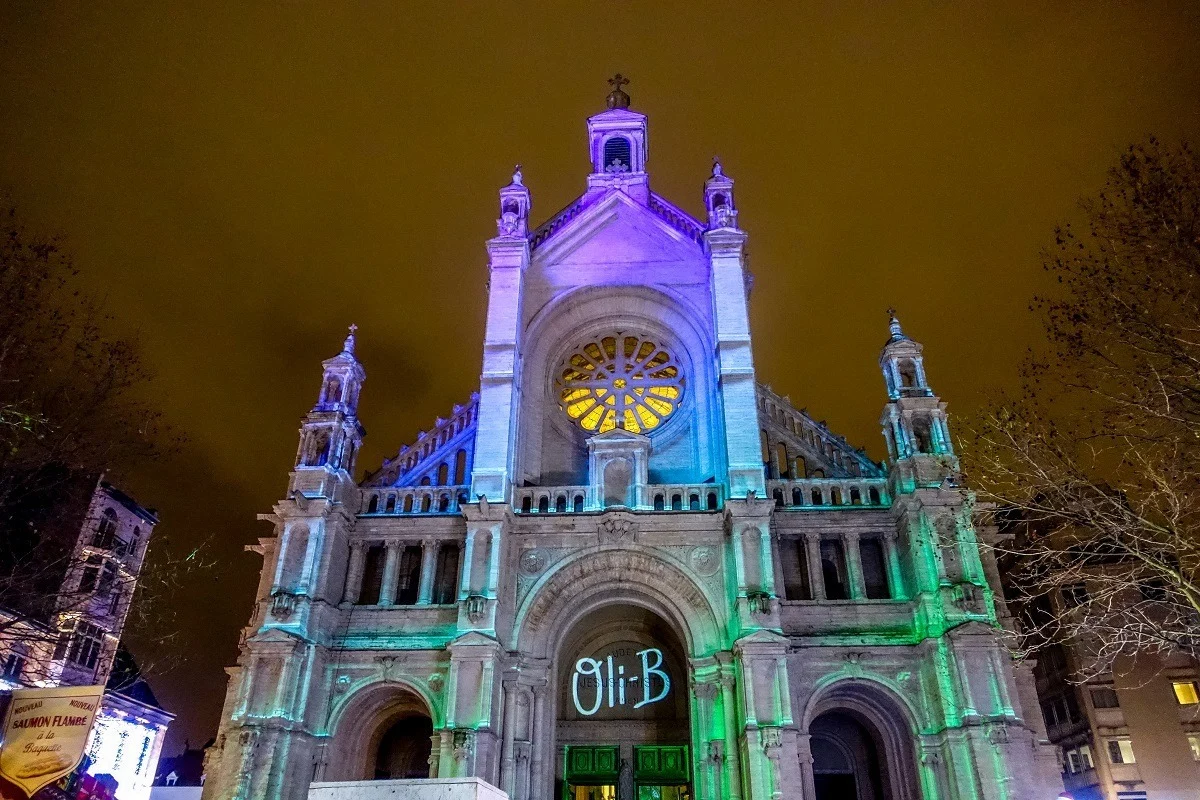
By the time we reached Place Sainte-Catherine, it was hard to believe there could be more to see, but we were really just getting started.
The square in front of St. Catherine’s Church was filled with food and beverage stalls, and the church itself became part of the celebrations. As in Grand Place, the façade of the church was lit up in a spectacle every half-hour throughout the night. Abstract shapes and bright colors crawled across the building in a unique display of video mapping while crowds gathered to watch the show.
Behind the church is where it got even more festive.

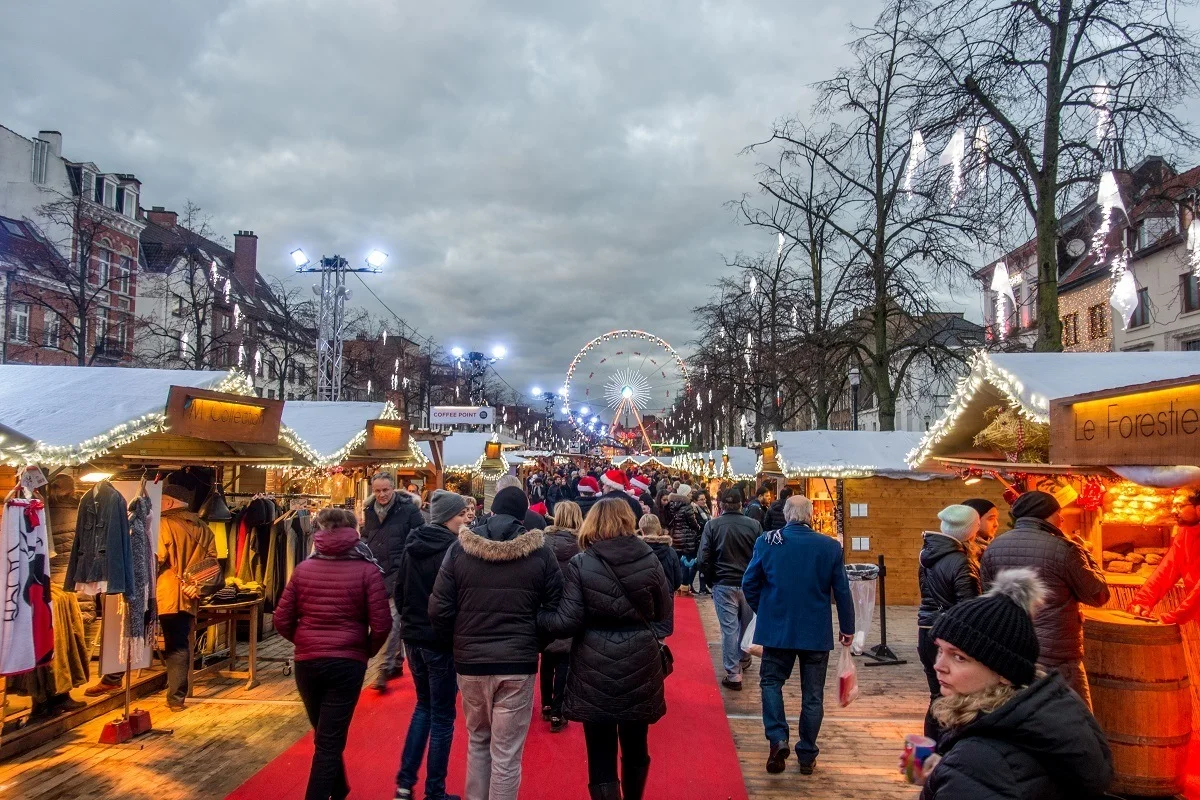
Stretching out through the Marché aux Poissons (the old fish market) were row upon row of vendors. Some huts pedaled tartiflette, a cheesy potato concoction, while others sold Belgian beer and local liquor. There were winter slippers, Christmas village houses, scarfs, hats, and anything practical or impractical you could ever want for the holiday season.
In the middle of it all, a cheerful carousel welcomed some of the smallest visitors. At the end of the rows, a giant, illuminated Ferris wheel and other fairground attractions kept everyone entertained.

We wandered the lanes, contemplating what to buy and what to eat. Then we wandered them again to finally make our selections. And another time just because it was so much fun.
Tour Noire

Just behind St. Catherine’s Church, the Tour Noire (Black Tower) is one of the best-preserved medieval relics in Brussels. It was once part of the city wall but is now surrounded by a modern hotel.
The square at the foot of Tour Noire hosts a cozy market. We found an igloo tent where musical performances took place throughout the market season. There were also chalets with food and crafts and a selection of offerings from Canada, in case you have a craving for maple syrup or need a syrup-scented candle (I did).
This year, the area at the Tour Noire caters heavily to children with storytelling, musicians, street art, and more.

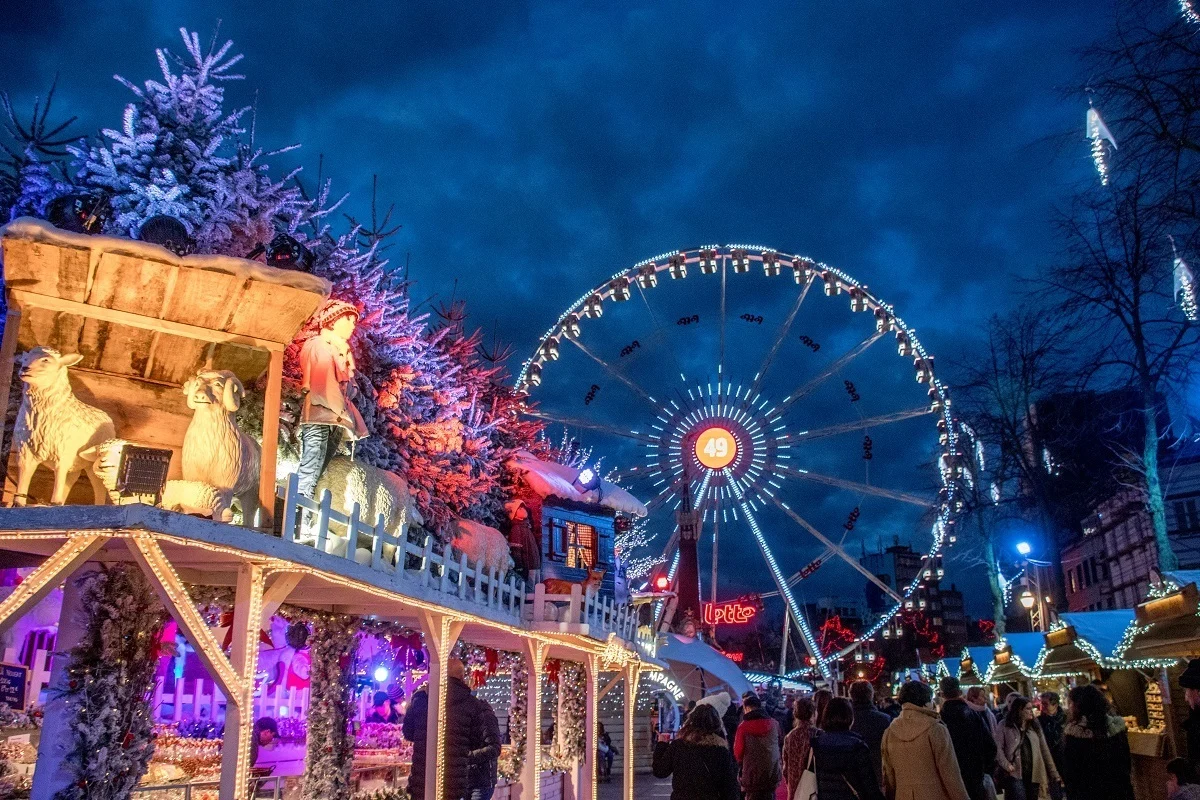
What to eat in Brussels at Christmas
Along with the lights, decorations, shopping, and music, eating and drinking is a key part of the fun at the Christmas markets. Keep a look out for these treats as you make your way through the aisles of chalets.
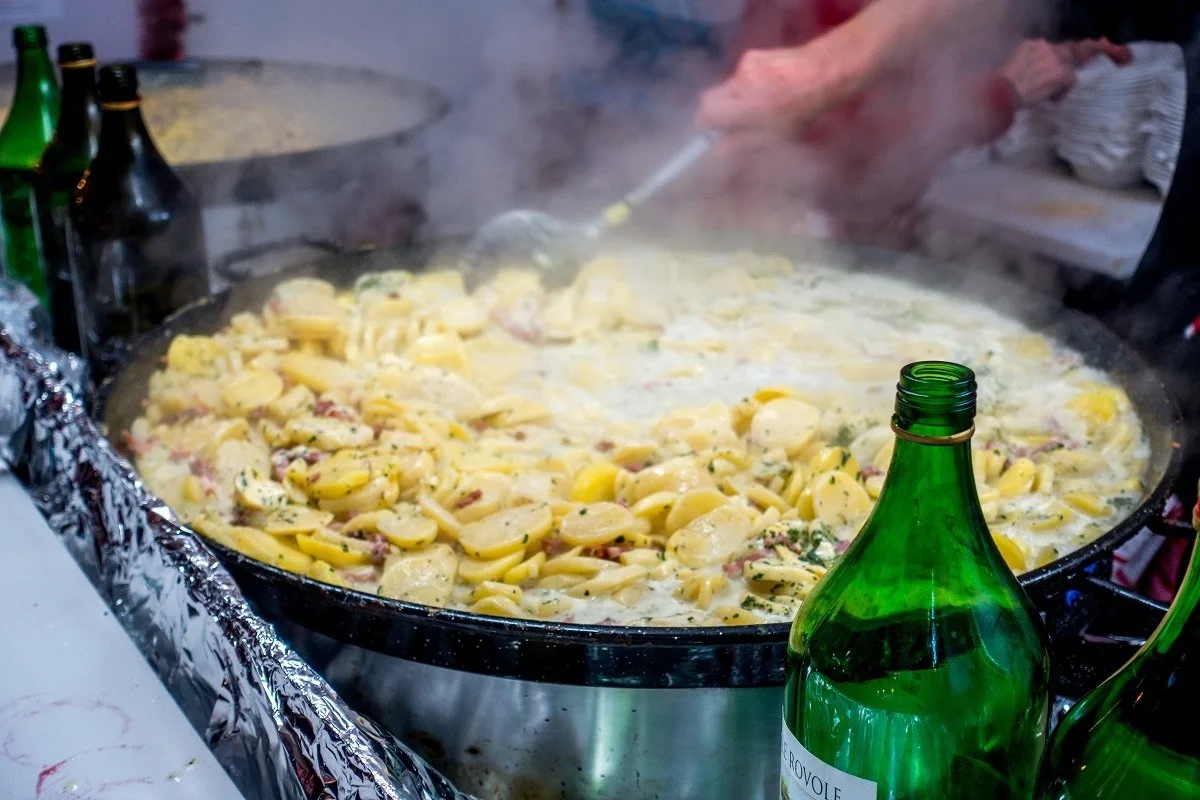
Tartiflette – While it’s not Belgian in origin, tartiflette is one of the most popular dishes in the Belgium Christmas markets. Made in giant skillets that look like paella pans, tartiflette is a warm, filling dish made with potatoes, cheese, lardons, onions, and white wine. It’s the perfect comfort food for a day at the markets.
Gluhwein/Vin chaud – The most popular drink at the Christmas markets is gluhwein. Hot mulled wine infused with spices like cinnamon and cloves, it’s the perfect thing to keep you warm.
Waffles– Waffles are practically synonymous with Brussels, but did you know there’s no such thing as a Belgian waffle? Instead, look for the sweeter, more compact Liege waffle or a fluffier Brussels waffle. Either way, make sure you’re getting a hot, freshly made one—not one that’s been sitting around awhile. If you can’t find what you’re looking for in the market, head to Maison Dandoy for a delicious treat.

Oysters – One may not think of a Christmas market or a street food stand as the place to go for oysters, but you’d be missing out. Throughout the old town, there are a handful of stands selling oysters and other seafood along with great white wines and champagne. It’s the perfect treat to accompany the light show at Place Sainte-Catherine.
Genever – We first came to love genever, a popular clear spirit, when we visited Amsterdam. It’s been around for 500 years, and, back then, the Netherlands and Belgium were part of the same kingdom, so the stuff we loved in the Netherlands is the same in Belgium.
Genever is called the grandfather of gin. A juniper flavored spirit, genever is a combination of neutral alcohol and malted wine. It’s available in dozens of flavors in the Brussels Xmas market—plain, fruity, nutty, chocolaty, and more. You can sample the flavors by the shot, typically for about 2€.

Market opening times
This season, the markets will be open November 24 through December 31, 2023. The festivities at Grand Place, Place De Brouckère, and Place de la Monnaie continue through January 7, 2024.
They are open every day from 12 pm to 10 pm, except for Christmas Eve and New Year’s Eve when the markets close at 6pm.
Tips for visiting the markets
The easiest route for visiting the markets (especially if you’re coming from the Central Station) is to start at Grand Place and work your way northwest—first to the Bourse, then onto Place de la Monnaie, Place de Brouckère, Place Sainte-Catherine/Vismet, Tour Noire, and the Marché aux Poissons.
Weekends are the most crowded, so avoid them, if you can.
During our visit, Christmas Eve at the markets was much less crowded than Christmas Day when it seemed like the whole city had piled into the streets to enjoy the festivities.
Keep an eye on your belongings, especially if you’re carrying shopping bags—it’s easy for things to go missing in crowded places.
More things to do at Christmas
If you’re visiting Brussels in winter, don’t miss the opportunity to see the other great things this beautiful city has to offer.
See the lights

More than 100 streets in the city center are lit up with thousands of lights for the holiday season. You’ll find Christmas trees, giant snowflakes, sparkling arches, lanterns, and plenty more decorations. It makes window shopping and strolling the streets at night a unique joy.
See the view from the Mont des Arts
One of the best views in the city is from the Mont des Arts (Kunstberg). Head to the top of the hill not far from the Royal Museums of the Fine Arts and adjacent to the Musical Instrument Museum to look out over the garden below and see the spire of Town Hall.
Don’t miss Manneken Pis

The curious, 2-foot-tall peeing boy statue known as Manneken Pis is the top attraction. At all hours of the day, tourists pour down the street to see the small figure, which was originally made all the way back in 1619. If you’re lucky, you just might see him dressed up. (To see his full wardrobe, head to the GardeRobe MannekenPis).
Go on a beer crawl
Even if you’ve had your fill of gluhwein and genever, you can’t miss trying Belgian beer. One of the most famous places to try lambic beer is Cantillon Brewery (aka Brasserie Cantillon), and you can visit the historic brewery itself just a 20-minute walk from the city center. Take a self-guided tour through the working brewery and sample their famous gueuze and kriek lambics right from the source.
If you can’t make it to Cantillon, there are plenty of places to try their beers and other Belgian specialties in town. Some of the most famous beer bars in Brussels include A Mort Subite, Moeder Lambic, and Poechenellekelder near Manneken Pis. Delirium bar, which has 2000+ beers on its list and is easily recognized by its pink elephant logo, is also one of the top spots for sampling beers in the heart of the city.
Walk the Comic Book Route

If you’re interested in unique street art or comics, include a few stops on the Comic Book Route on your list of what to do in Brussels. There are more than 50 murals highlighting classic comic book characters and authors as well as aspects of city life and other unique scenes. If that’s not enough, stop by the Comic Book Museum to learn about the history of comics and how they’re made.
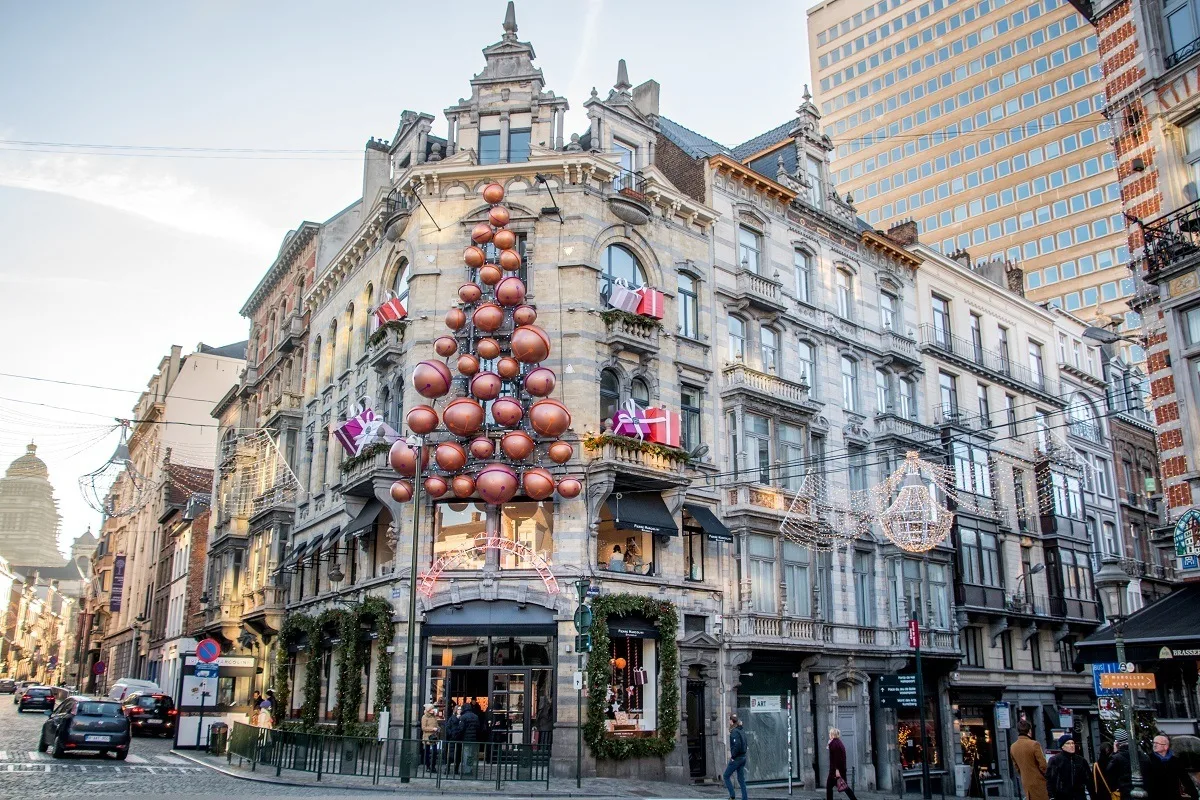
Where to stay
There are lots of great places–both hotels and B&Bs–to stay both in the city center and in nearby neighborhoods. For even more options and reviews, take a look at more of our accommodations recommendations in Brussels.
Art de Séjour– In the heart of the city, Art de Séjour is an exceptional bed and breakfast offering personalized service from an owner who is invested in helping his guests have a great trip. Set in a renovated 19th-century townhouse, Art de Séjour has spacious rooms with wifi, satellite TV, and a Nespresso machine.
Warwick Brussels–Three blocks from Grand Place and only two blocks from the central train station, the Warwick is close to the main attractions but just far enough away to keep noise to a minimum. One of the best hotels in Brussels, the Warwick offers high-end amenities like a fitness center and sauna, three on-site restaurants, and even butler service.
Maison Flagey – In the trendy Ixelles neighborhood, you’ll find many historic Art Deco buildings. One such building from 1906 is home to Maison Flagey, a comfortable B&B offering modern amenities in this classic setting. Breakfast and wifi are included in your stay.
Laura Longwell is an award-winning travel blogger and photographer. Since founding Travel Addicts in 2008, she has written hundreds of articles that help over 3 million people a year get the most out of their travel. In that time, she has visited nearly 60 countries on 5 continents, often returning to favorite destinations over and over again. She has a deep love of history, uncovering unexpected attractions, and trying all the good food a place has to offer.
In addition to Travel Addicts, Laura runs a site about her hometown of Philadelphia—Guide to Philly—which chronicles unique things to do and places to see around southeastern Pennsylvania. Her travel tips and advice appear across the web.

